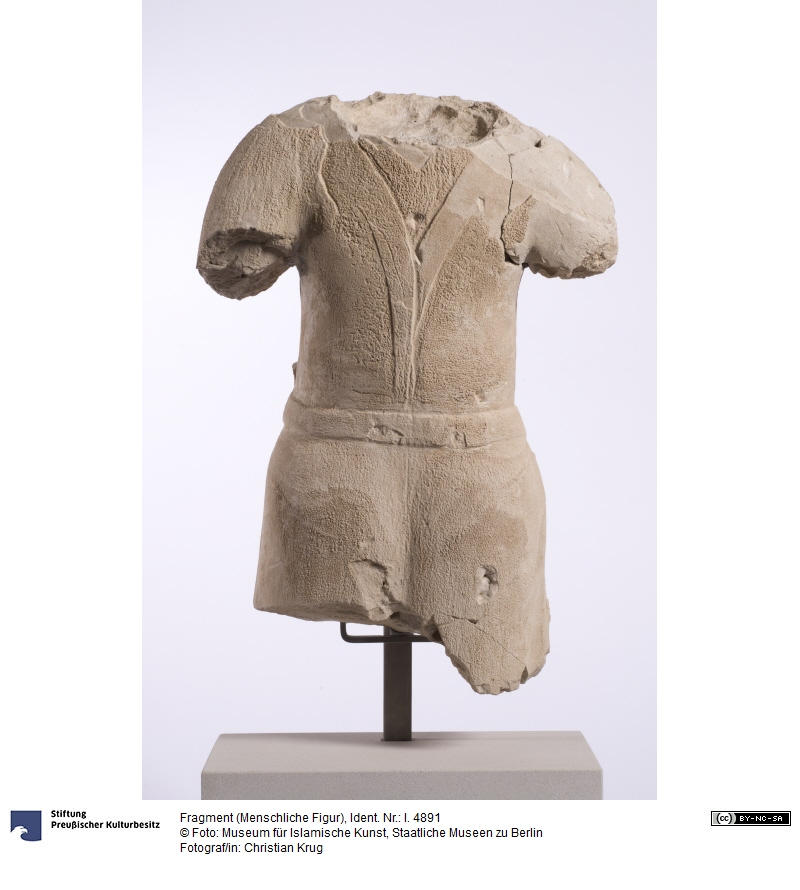
Find the perfect fit with Amazon Prime. Try Before You Buy.
Sasanid Statuette Fragment. Nizamabad, Iran, 7th - 8th century.
Museum für Islamische Kunst der Staatlichen Museen zu Berlin I. 4891



Fragment (Menschliche Figur)
7./8. Jahrhundert
Dynastie: Sasaniden
Herkunft (Allgemein): Iran (Land)
Herkunft (Allgemein): Nizamabad (Ort)
Gips, geformt, geschnitten, geglättet
Höhe: 51,5 cm
Breite: 35,5 cm
Tiefe: 31 cm
Höhe: 66,5 cm mit Sockel
Tiefe: 19 cm mit Sockel
Ident.Nr. I. 4891
Sammlung: Museum für Islamische Kunst
© Foto: Museum für Islamische Kunst der Staatlichen Museen zu Berlin - Preußischer Kulturbesitz
Fotograf/in: Christian Krug
Description: Fragment einer fast vollständig rundplastisch gearbeiteten Darstellung einer männlichen Figur aus Stuck. Erhalten ist ein Torso, dessen Kopf und Arme fehlen. Der Oberkörper ist von einem eng anliegenden Mantel bedeckt, der am Hals weit aufgeschlagen und knapp oberhalb der Hüfte gegürtet ist.
Die Oberfläche ist glatt gearbeitet, so dass es wahrscheinlich ist, dass sie mit Bemalung verziert war. Die Rückseite ist nicht vollständig rundplastisch geformt.
Es wird angenommen, dass der Kopf I. 4891a zu dieser Figur gehörte.
Das Fragment wurde Anfang des 20. Jahrhunderts zusammen mit anderen Stuckplatten und Hochreliefs 80km südöstlich von Teheran im Gebiet von Nizamabad geborgen. Das Museum erwarb die Stücke im Kunsthandel.
Fast vollplastisch ausgearbeitete Reiter- und Personendarstellungen stechen unter den verschiedenen Stuckfunden heraus. Sie sind durch Kronen, Schmuck, Bekleidung sowie Farbfassungen und Blattgoldbelag als hochrangige Personen gekennzeichnet.
Die Funde aus Nizamabad sind in das 7./8. Jahrhundert zu datieren. Sie sind herausragende Zeugnisse der Übergangszeit zwischen Spätantike und Frühislam.
Fragment (human figure)
Dating: 7th - 8th century
Dynasty: Sasanid
Origin (general): Iran (Country)
Origin (general): Nizamabad (place)
Plaster, shaped, cut, smoothed
Height: 51.5 cm
Width: 35.5 cm
Depth: 31 cm
Height: 66.5 cm with base
Depth: 19 cm with base
ID No. I. 4891
Collection: Museum of Islamic Art
© Photo: Museum of Islamic Art of the National Museums in Berlin - Prussian Cultural Possessions
Photographer: Christian Krug
Description: Fragment of an almost completely round plastic representation of a male figure made of stucco. Preserved is a torso, whose head and arms are missing. The upper body is covered by a close-fitting coat, which is wide at the neck and girt just above the hips.
The surface is smooth, so it is likely that it was decorated with paint. The back is not completely sculpted.
It is believed that the head I. 4891a belonged to this figure.
The fragment was recovered in the early 20th century along with other slabs and high reliefs 80km southeast of Tehran in the Nizamabad area. The museum acquired the pieces in the art trade.
Almost fully sculpted rider and person portraits stand out among the various stucco finds. They are marked as high-ranking persons by crowns, jewelery, apparel, as well as polychromy and gold leaf.
The finds from Nizamabad are in the 7th-8th centuries date range. They are outstanding evidence of the transitional period between late antiquity and early Islam.